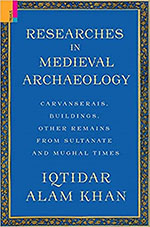A collection of eight essays which variously analyse the oft under-explored subject of medieval archaeology, the book under review brings to light not only many hitherto unknown structural remains belonging to medieval India such as dyeing vats, dykes and makeshift capitals but also aims to dispel the notion that archaeology as a discipline is only associated with the remote past or with ‘remains dug out from under the earth’ (p. 2). Khan’s book points to a plethora of structural remains pertaining to medieval India that are lacking in conservation primarily because they do not make the cut for being ‘important’ monuments. Khan rightfully blames the British for such arbitrary lists where historical structures such as waterworks and bridges were condemned as ‘impossible or unnecessary to preserve’ (p. 5).
Accordingly, the book with each essay brings forth examples of some unique monuments and highlights their significance in the larger history of medieval India. For example, in ‘Muhammad Bin Tughlaq’s Temporary Capital at Suargduari’, Khan discusses the makeshift capital of Suargduari patronized by the Delhi Sultan, Mohammad bin Tughlaq. Through this discussion Khan sheds light on a number of structural remains buried underneath that made up the Capital and the need to expose them in order to understand the settlement in even greater detail. Similarly, the chapter, ‘Two Early Mughal Monuments of Bayana’ explores the curious Manzil of Mohammad Sultan, a bakshi (paymaster) of the Mughal Emperor Humayun and reveals how the architecture of the Manzil built in the post and lintel architecture was clearly a precursor for the Panch Mahal in Mughal Emperor Akbar’s capital of Fatehpur Sikri in Agra.

